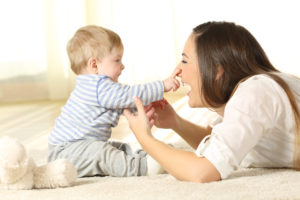How to Build a Secure Attachment With Your Child
We all want what’s best for our children, but who knew we could begin to give them this from day 1? It all starts with building a secure attachment.
What is Attachment?
You’ve may have heard of the term attachment before, but what exactly is it? Let me tell you a little story from my past to help me explain.
When my husband’s nephew was born, he naturally wanted to spend a good deal of time with this new little one, which meant I was also spending a lot of time with him. Initially, I was all about it, because I love babies! But I was also 20-something and enjoying all that life brings during that time. So when my husband started to make our visits with his nephew into a weekly thing, I started to feel a bit frustrated. The grandiose lifestyle of the average 20 year old is fairly incompatible with the world of babies, and so it was cramping my style!
But I wanted to spend time with my then-boyfriend, so I kept joining him in the baby care. We went on little outings together, we played endless amounts of peek-a-boo, and we learned about all those specific little habits that only people who know you well get to learn.
And then something strange happened. One week my boyfriend said we wouldn’t be able to see his nephew at all that weekend. And I was disappointed. Wait… what?! Where did that feeling come from?! How did I go from feeling frustrated that we were seeing too much of his nephew, to disappointed that we weren’t seeing him enough?
The answer is attachment. That invisible, ever-powerful dynamic that keeps us coming back to the ones we love. Attachment is the reason we turn toward our crying babies to soothe them, and it is the reason we put our own lives on hold in order to tend to their needs.
The Four Components of Attachment
Bonding is what most people think of when we hear the word “attachment,” and it refers to the connection we have between ourselves and our babies. For some people, this bond can happen while the baby is still in the womb, while others will feel the bond after seeing their baby for the first time, and there are others who will require time getting to know their baby before the bond really becomes established. All of these are completely normal!
Attunement occurs when we pay attention to what our babies are trying to communicate, through their cries, their facial expressions, and their body language. Attunement allows us to notice when they like or dislike something, and it helps us learn their cues for hunger and sleep. When we follow our baby’s lead, we convey a deep respect for them right from the beginning. It is not just forcing our lifestyle and our preferences on our baby. It is also that we bend to accommodate their own unique way of being in the world.
Responsiveness occurs when we use the information we gathered through our attunement to respond to our baby’s needs and desires. We are being responsive when we feed our baby when he is hungry, when we help our baby sleep when he is tired, and when we stop our play when he is overstimulated.
And finally, consistency is about putting the pieces together to identify and respond to our babies’ needs regularly and predictably over time. It’s about teaching our babies that we are there for them and they can rely on us always. Of course, as parents we are still human, and there will be times where we don’t get it quite right. And that’s ok. Attachment isn’t about being perfect parents. It’s about being there for our kids enough of the time that we help them to feel safe and secure that we will be there for them when they really need us.
When you get it mostly right, your child will develop a secure attachment. And when something goes awry, they will develop an insecure attachment. So what can we do to foster that secure attachment?

Building a Secure Attachment Through Our Interactions
For some people, building a secure attachment relationship with their child might come naturally. If that’s you, power to you, keep doing what you’re doing and no need to read any further. But many of us need more guidance to help us get our kids on the right path. This might be because we never experienced a secure relationship with our own parents (it’s hard to do something we’ve never seen modeled to us). Or perhaps we doubt ourselves and just need some reassurance on what we’re already doing. Or maybe we’re already doing some really great stuff and just need a few extra ideas of how to keep the momentum going. Check out the following tips on what to do to facilitate each component of attachment with your child.
How to Work on Bonding
- Talk to your baby. Respond to their coos and babbles like it’s a conversation
- Play silly games with your baby
- Enjoy your baby’s smell and softness
- Participate in the care of your baby (feeding, changing, bathing, putting to sleep) and be mindfully present as you do those things
- Take responsibility for at least one task so your baby can come to rely on you for that (this is especially important for dads who can feel left out)
How to Work on Attunement
- Pay attention to your interactions together
- Observe your baby’s reactions to your behavior
- Does your baby turn toward you, stop crying, or settle down?
- Does your baby turn away, continue crying, or shut his or her eyes?
- Notice the intensity of your baby’s behavior (crying, eye contact, facial expressions)
- Learn to differentiate between your baby’s different cries
- Consider all of these nonverbal cues as your baby’s way of communicating with you
How to Work on Responsiveness
- Gather the cues that your baby is giving you and use them to adjust your behavior
- If your baby turns towards you, stops crying, smiles, or settles down, keep doing what you’re doing
- If your baby turns away, continues crying, or forcefully shuts their eyes, stop and try something else
- Modify your tone of voice, pitch, intensity of touch, and facial expressions
- Notice how your baby responds to each change you make in your behavior, and continue those behaviors your baby appears to respond well to
- This step is learning how to modify your way of interacting so it matches your baby’s way
How to Work on Consistency
- Use the information you’ve gained through your attunement and responsiveness to develop a consistent approach that matches your baby’s needs (If your baby prefers quiet, try and consistently lower your voice and keep the noises in the house at a lower level. If your baby responds to high energy, set aside time consistently to play the music loud, sing songs animately, and play enthusiastically)
- Continue doing your best to meet your baby’s physical, emotional, and social needs in the manner that suits them
- Do your best to minimize the extent that variations in your mood impact your response to your baby (utilizing or developing your own good coping skills is necessary here)
- The goal is to be reliable (responding most times) and predictable (responding in a similar way every time)
You might have noticed that none of these ideas are groundbreaking, and that’s kind of the point. Helping your child build a secure attachment with you doesn’t have to be hard or complicated. It’s just a few simple behaviors, repeated over and over and over again, and voila!… before you know it, you’ve gone and raised a happy, healthy, and capable child.
____
Dana Basu, PsyD is a licensed clinical psychologist and founder of EverGROW therapy. She provides individual therapy, support groups, and online resources for parents in Orange County and throughout the state of California via online therapy. She specializes in working with people with difficult childhood experiences, trauma, parenting stress, and chronic guilt.


